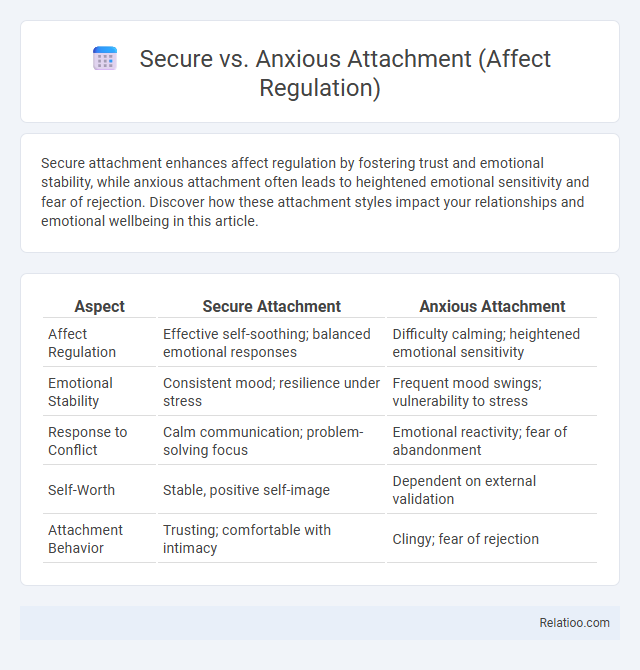Secure attachment enhances affect regulation by fostering trust and emotional stability, while anxious attachment often leads to heightened emotional sensitivity and fear of rejection. Discover how these attachment styles impact your relationships and emotional wellbeing in this article.
Table of Comparison
| Aspect | Secure Attachment | Anxious Attachment |
|---|---|---|
| Affect Regulation | Effective self-soothing; balanced emotional responses | Difficulty calming; heightened emotional sensitivity |
| Emotional Stability | Consistent mood; resilience under stress | Frequent mood swings; vulnerability to stress |
| Response to Conflict | Calm communication; problem-solving focus | Emotional reactivity; fear of abandonment |
| Self-Worth | Stable, positive self-image | Dependent on external validation |
| Attachment Behavior | Trusting; comfortable with intimacy | Clingy; fear of rejection |
Understanding Attachment: Secure vs Anxious Styles
Secure attachment promotes effective affect regulation through consistent emotional support, fostering resilience and healthy coping mechanisms. Anxious attachment often leads to heightened emotional reactivity and difficulty managing stress due to inconsistent caregiving and fear of abandonment. Understanding these attachment styles is crucial to developing strategies that enhance emotional regulation and interpersonal relationships.
The Science of Affect Regulation in Attachment
Secure attachment promotes effective affect regulation by fostering emotional responsiveness and stability through consistent caregiver support, enhancing the ability to manage stress and emotional challenges. In contrast, anxious attachment disrupts affect regulation, leading to heightened emotional reactivity, difficulty calming distress, and reliance on external validation to soothe negative feelings. Scientific studies reveal that neural pathways involving the prefrontal cortex and amygdala are differently activated in secure versus anxious attachment styles, underpinning the cognitive and emotional processes essential for adaptive affect regulation.
Characteristics of Secure Attachment
Secure attachment is characterized by consistent emotional availability and responsiveness from caregivers, fostering trust and a positive self-image in the individual. Individuals with secure attachment effectively regulate their emotions, demonstrating resilience and adaptability in stressful situations. This healthy affect regulation supports strong interpersonal relationships and promotes psychological well-being.
Traits of Anxious Attachment
Anxious attachment is characterized by heightened sensitivity to rejection, persistent fear of abandonment, and difficulty regulating emotional responses, often leading to increased stress and relationship insecurity. You may experience intense emotional fluctuations and a strong need for reassurance, which impacts your ability to manage affect effectively. This contrasts with secure attachment, where affect regulation is balanced and emotional responses are moderated, fostering healthier interpersonal relationships.
How Secure Attachment Influences Emotional Regulation
Secure attachment fosters effective affect regulation by providing a foundation of emotional safety and trust, allowing individuals to recognize and manage their feelings adaptively. Your ability to cope with stress and maintain emotional balance improves through secure attachment experiences, as they enhance self-soothing and resilience skills. In contrast, anxious attachment often leads to heightened emotional reactivity and difficulty calming distress, disrupting optimal affect regulation.
Anxious Attachment and Challenges with Affect Regulation
Anxious attachment is characterized by heightened emotional sensitivity and an intense need for reassurance, often leading to difficulties in affect regulation such as mood swings and increased stress response. Individuals with anxious attachment struggle to manage negative emotions effectively, resulting in heightened vulnerability to anxiety, rumination, and interpersonal conflicts. These challenges in affect regulation hinder emotional resilience and contribute to persistent relational instability.
Neurobiological Basis of Attachment and Affect
Secure attachment is characterized by adaptive affect regulation supported by balanced activity in the prefrontal cortex and limbic system, facilitating effective emotional processing and resilience. Anxious attachment involves hyperactivation of the amygdala and dysregulated cortisol responses, leading to heightened emotional reactivity and difficulties in managing stress. Neurobiological studies reveal that secure attachment fosters optimal connectivity between the prefrontal cortex and limbic structures, promoting stable affect regulation, whereas anxious attachment disrupts these circuits, impairing emotional homeostasis.
Impact of Attachment Styles on Relationships
Secure attachment fosters healthy affect regulation, enabling individuals to maintain emotional balance and build trust in relationships. Anxious attachment often leads to heightened emotional reactivity and difficulty managing stress, causing challenges such as clinginess or fear of abandonment. These attachment styles significantly influence relationship satisfaction, communication patterns, and conflict resolution effectiveness.
Strategies to Develop Secure Attachment and Healthy Affect Regulation
Secure attachment and healthy affect regulation involve strategies such as consistent emotional availability, open communication, and mindful self-awareness to foster emotional stability. You can develop secure attachment by practicing empathy, setting clear boundaries, and engaging in reflective listening to build trust and safety in relationships. Enhancing affect regulation includes techniques like deep breathing, cognitive reappraisal, and grounding exercises that help manage emotional responses effectively.
Seeking Support: Therapy and Recovery for Insecure Attachment
Secure attachment fosters healthy affect regulation through consistent emotional support and trust, enabling You to seek support effectively during therapy and recovery. Anxious attachment often leads to heightened affect dysregulation, causing challenges in managing emotions and reliance on reassurance-seeking behaviors. Targeted therapy for insecure attachment improves affect regulation by developing coping strategies and fostering secure relational patterns for sustained recovery.

Infographic: Secure vs Anxious Attachment (Affect Regulation)
 relatioo.com
relatioo.com